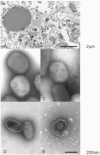Orthopox Viruses: Infections in Humans
- PMID: 21483466
- PMCID: PMC3048946
- DOI: 10.1159/000322101
Orthopox Viruses: Infections in Humans
Figures

References
-
- Ladnyi ID, Breman JG. Smallpox eradication: progress and problems. Dev Biol Stand. 1978;41:281–290. - PubMed
-
- Geddes AM. The history of smallpox. Clin Dermatol. 2006;24:152–157. - PubMed
-
- WHO Global Commission for the Certification of Smallpox Eradication, editor. The Global Eradication of Smallpox. Final Report of the Global Commission for the Certification of Smallpox Eradication, Geneva, 1979. Geneva: WHO; 1980.
-
- Fenner F, Henderson DA, Arita I, Jezek Z, Ladnyi ID: Smallpox and Its Eradication – World Health Organisation 1988. http://whqlibdoc.who.int/smallpox/9241561106.pdf
LinkOut - more resources
Full Text Sources
Other Literature Sources

